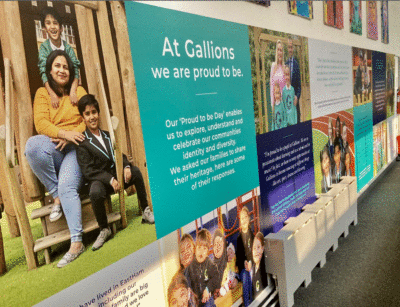View our Pupil Equality Policy here

At Gallions, we celebrate our wide range of pupils from many different backgrounds. A huge priority for us this year is promoting diversity and equality throughout many different areas of our school through implementing the ‘Education 4 Change’ project (E4C).
 E4C is a programme designed for educators by educators to ensure schools provide high-quality, practical opportunities to explore diversity and racial issues in a meaningful way. E4C aims to engage and open minds by challenging, inspiring and motivating children and young people to both prepare for, and call out, racism when they experience or encounter it. The project will empower schools and their communities to have the difficult conversations about the existence and widespread impact of racism, ultimately raising expectations, shifting mindsets and enabling children and young people that encounter racism to overcome real and perceived barriers.
E4C is a programme designed for educators by educators to ensure schools provide high-quality, practical opportunities to explore diversity and racial issues in a meaningful way. E4C aims to engage and open minds by challenging, inspiring and motivating children and young people to both prepare for, and call out, racism when they experience or encounter it. The project will empower schools and their communities to have the difficult conversations about the existence and widespread impact of racism, ultimately raising expectations, shifting mindsets and enabling children and young people that encounter racism to overcome real and perceived barriers.
This exciting project launched at Gallions in November 2021. We are currently critically looking at our curriculum and making adaptations for it to be more inclusive and reflective of our local context.
Here are some examples of equality and diversity in the Gallions curriculum:
| English |
| In Year 3, pupils study as an alternative fairy tale, Beverly Naidoo’s Cinderella of the Nile, taking an existing fairy tale and placing it in Africa, reflecting more of our pupils.
In Year 4 they look at ‘Cinnamon’ which is a retelling of an old fairy tale using an Asian setting. This is used to work on narratives. Year 6 use ‘Boy in the Tower’ about a young black boy who lives in a tower block in South London. It is used to teach narrative writing. |
| Science |
| Year 5 study ‘Hidden Figures’ to highlight the contribution of segregated African American women who worked at NASA during the Space Race. They also look at the work of Dr Maggie Aderin-Pocock, British Space Scientist and space educator.
Year 4 will read Race to the Frozen North and learn about the achievement of Mathew Henson in exploration of North Pole and how his achievement was ignored due to the colour of his skin. Also in Year 4, when studying electricity they explore the life changing work and invention of William Kamkwamba who is a Malawian inventor and engineer. |
| History |
| We changed our Year 6 history unit to look at the ancient Benin kingdom, which allows us to celebrate the achievements of this powerful civilisation and investigate the impact of the British Empire and colonialism.
Also, in our Year 2 history unit we rewrote our curriculum to study inspirational historical figures focusing on people from more diverse backgrounds, women and those with disabilities. |
| Computing |
| In Computing each unit now has a list of inspirational people in the planning that links to the area of the being covered by the unit. Teachers can then use these people as examples of how the new knowledge or skills being taught can be applied to the real world. Children will hopefully see themselves in the examples given. Some examples are:
Anne-Marie Imafidon – A Newham-raised coder who supports girls and young women who are looking for a career in coding. |
| Geography |
| In geography, children have the opportunity to learn about issues facing countries around the world. For example, Year 2 students learn about Dhaka in Bangladesh, and compare the city to the place where they live. |
| Phonics |
| We carefully vet our books and resources to represent our diverse community. If necessary, we remove any resources or books that do not suit our Gallions vision. We are in open dialogue with our staff and our reading scheme about how resources can be upgraded and improved. |
| EYFS |
| EYFS start the academic year by learning ‘All about me’. The focus is on the children recognising and valuing the similarities and differences between themselves. They read the text ‘Hair love’ by Matthew A Cherry and practice creating their own hairstyles on a selection of mannequins.
In art they build up their skills of drawing lines and then produce their own self – portraits, with a focus on representing and loving their own hair. |
| RE |
| As part of RE and our study of the faiths and beliefs in our community, we do many things which promote positive messages involving Equality for Change. We are conscious of images used such as Jesus being shown as a black man, or Asian man.
Through teaching about a variety of religions and stories from different cultures, races and countries we ensure that we are not presenting religion in a western way. Everything we teach contributes to tolerance and respect. |
